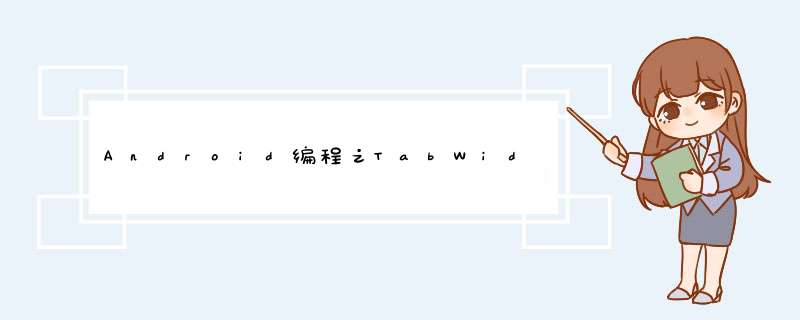
本文实例讲述了AndroID编程之TabWidget选项卡用法。分享给大家供大家参考,具体如下:
1 概览
TabWidget与TabHost。tab组件一般包括TabHost和TabWidget、FrameLayout,且TabWidget、FrameLayout属于TabHost。
是否继承tabactivity的问题
实现步骤。两种实现方式,一种是将每个Tab的布局嵌在TabHost中的FrameLayout中,每个Tab的内容布局与显示都在FrameLayout中进行,缺点是布局会显得很臃肿;一种是每个Tab从FrameLayout中独立出来,以Activity呈现,这样使得每个Tab有单独的布局。
2 效果图
Widget在顶部的情形:
3 主要布局
3.1 TabMain布局
方式一:
<?xml version="1.0" enCoding="utf-8"?><TabHost xmlns:androID="http://schemas.androID.com/apk/res/androID" androID:ID="@+ID/tabhost" androID:layout_wIDth="match_parent" androID:layout_height="match_parent" androID:orIEntation="vertical" > <relativeLayout androID:layout_wIDth="fill_parent" androID:layout_height="fill_parent" androID:orIEntation="vertical" > <TabWidget androID:ID="@androID:ID/tabs" androID:layout_wIDth="fill_parent" androID:layout_height="60dip" androID:layout_alignParentBottom="true" androID:background="#424242" > </TabWidget> <FrameLayout androID:ID="@androID:ID/tabcontent" androID:layout_wIDth="fill_parent" androID:layout_height="fill_parent" > <linearLayout androID:ID="@+ID/theme" androID:layout_wIDth="fill_parent" androID:layout_height="fill_parent" androID:orIEntation="vertical" > <TextVIEw androID:ID="@+ID/theme_Title" androID:layout_wIDth="wrap_content" androID:layout_height="wrap_content" androID:text="Tab1" /> </linearLayout> <linearLayout androID:ID="@+ID/wallpaper" androID:layout_wIDth="fill_parent" androID:layout_height="fill_parent" androID:orIEntation="vertical" > <TextVIEw androID:ID="@+ID/wallpaper_Title" androID:layout_wIDth="wrap_content" androID:layout_height="wrap_content" androID:text="Tab2" /> </linearLayout> <linearLayout androID:ID="@+ID/iconbg" androID:layout_wIDth="fill_parent" androID:layout_height="fill_parent" androID:orIEntation="vertical" > <TextVIEw androID:ID="@+ID/iconbg_Title" androID:layout_wIDth="wrap_content" androID:layout_height="wrap_content" androID:text="Tab3" /> </linearLayout> <linearLayout androID:ID="@+ID/screenlock" androID:layout_wIDth="fill_parent" androID:layout_height="fill_parent" androID:orIEntation="vertical" > <TextVIEw androID:ID="@+ID/screenlock_Title" androID:layout_wIDth="wrap_content" androID:layout_height="wrap_content" androID:text="Tab4" /> </linearLayout> <linearLayout androID:ID="@+ID/effect" androID:layout_wIDth="fill_parent" androID:layout_height="fill_parent" androID:orIEntation="vertical" > <TextVIEw androID:ID="@+ID/effect_Title" androID:layout_wIDth="wrap_content" androID:layout_height="wrap_content" androID:text="Tab5" /> </linearLayout> </FrameLayout> </relativeLayout></TabHost>
方式二:
<?xml version="1.0" enCoding="utf-8"?> <TabHost xmlns:androID="http://schemas.androID.com/apk/res/androID" androID:ID="@androID:ID/tabhost" androID:layout_wIDth="fill_parent" androID:layout_height="fill_parent" androID:background="@color/wcity_normal_bg" > <linearLayout androID:layout_wIDth="fill_parent" androID:layout_height="fill_parent" androID:orIEntation="vertical" > <FrameLayout androID:ID="@androID:ID/tabcontent" androID:layout_wIDth="fill_parent" androID:layout_height="fill_parent" androID:layout_weight="1" > </FrameLayout> <TabWidget androID:ID="@androID:ID/tabs" androID:layout_wIDth="fill_parent" androID:layout_height="wrap_content" androID:background="@drawable/tab" /> </linearLayout></TabHost>
3.2 TabItem布局
这一部分中方式一与方式二没有什么区别,只有表示形式的区别。比如,根据需求,Tab可以
只以文字呈现,
可以只以图片呈现,
可以同时有图片和文字
其中有文字和图片的布局如下:
<?xml version="1.0" enCoding="utf-8"?><linearLayout xmlns:androID="http://schemas.androID.com/apk/res/androID" androID:layout_wIDth="fill_parent" androID:layout_height="fill_parent" androID:gravity="center_horizontal|center_vertical" androID:orIEntation="vertical" > <linearLayout androID:ID="@+ID/tabItem androID:layout_wIDth="wrap_content" androID:layout_height="wrap_content" androID:background="@drawable/bg_ispressed" androID:gravity="center_horizontal|center_vertical" androID:orIEntation="vertical" > <ImageVIEw androID:ID="@+ID/icon" androID:layout_wIDth="wrap_content" androID:layout_height="wrap_content" /> <TextVIEw androID:ID="@+ID/name" androID:layout_wIDth="wrap_content" androID:layout_height="wrap_content" /> </linearLayout></linearLayout>
3.3点击状态
Tab键点击后状态的问题,如果点击后,没有状态提示对用户是不友好的。点击状态的实现就是对TabItem布局的androID:background进行设置。例如:
上述TabItem中linearLayout的androID:background设置的属性:@drawable/bg_ispressed
其中bg_ispressed文件如下:
<?xml version="1.0" enCoding="utf-8"?> <selector xmlns:androID="http://schemas.androID.com/apk/res/androID"> <item androID:drawable="@drawable/tab_selected_bg" androID:state_pressed="false" androID:state_selected="true"/> </selector>
tab_selected_bg即是点击后变换的图片效果。
3.4 关于Tab位置的问题
Tab标签显示在顶部还是底部也是经常会遇到的问题。
通常TabMain布局中TabWidget在FrameLayout上面默认就是显示在顶部了,如果改成在底部显示,首先会想到的是直接调换顺序,将TabWidget放在FrameLayout后面。
情形一:
问题来了,tab栏直接消失掉(我试过),后来解决方法是:FrameLayout中添加属性:androID:layout_weight="1"。这种情形可以解决的条件是,TabWidget和FrameLayout被嵌套在linearLayout布局中,如果是其他则行不通。
情形二:
TabWidget与FrameLayout顺序任意,在TabWidget中添加属性
复制代码 代码如下:androID:layout_alignParentBottom="true"
当然,这种情形适合TabWidget和FrameLayout被嵌套在relativeLayout布局中,同样的,如果是其他则行不通。
注:以上两种情形也不是绝对的,只实践过以上两种情形,至于其他布局就不清楚了,具体问题具体分析吧。
4 继承tabactivity?
4.1 继承tabactivity与不继承的问题
继承不继承tabactivity,看自己习惯了,都能正确实现,没什么区别,至于在代码方面唯一的区别在于:
不继承tabactivity而继承Activity的需要在代码中加入:
复制代码 代码如下:mTabHost.setup();
4.2 主要代码
直接继承自Activity的代码
import java.util.ArrayList;import java.util.List;import androID.app.Activity;import androID.content.Context;import androID.os.Bundle;import androID.vIEw.LayoutInflater;import androID.vIEw.VIEw;import androID.Widget.ImageVIEw;import androID.Widget.linearLayout;import androID.Widget.TabHost;import androID.Widget.TextVIEw;public class TabDesignActivity extends Activity{ private Context mContex = this; private TabHost mTabHost; private String TAB1 = "tab1"; private String TAB2 = "tab2"; private String TAB3 = "tab3"; private String TAB4 = "tab4"; private String TAB5 = "tab5"; private List<linearLayout> menuItemList; @OverrIDe protected voID onCreate(Bundle savedInstanceState) { // Todo auto-generated method stub super.onCreate(savedInstanceState); setContentVIEw(R.layout.tab_main); menuItemList = new ArrayList<linearLayout>(); mTabHost = (TabHost) findVIEwByID(R.ID.tabhost); mTabHost.setup(); mTabHost.addTab(mTabHost.newTabSpec("tab1").setIndicator(getMenuItem(R.drawable.tab1_ispressed,TAB1)).setContent(R.ID.tab1)); mTabHost.addTab(mTabHost.newTabSpec("tab2").setIndicator(getMenuItem(R.drawable.tab2_ispressed,TAB2)).setContent(R.ID.tab2)); mTabHost.addTab(mTabHost.newTabSpec("tab3").setIndicator(getMenuItem(R.drawable.tab3_ispressed,TAB3)).setContent(R.ID.tab3)); mTabHost.addTab(mTabHost.newTabSpec("tab4").setIndicator(getMenuItem(R.drawable.tab4_ispressed,TAB4)).setContent(R.ID.tab4)); mTabHost.addTab(mTabHost.newTabSpec("tab5").setIndicator(getMenuItem(R.drawable.tab5_ispressed,TAB5)).setContent(R.ID.tab5)); } public VIEw getMenuItem(int imgID,String textID){ linearLayout ll = (linearLayout)LayoutInflater.from(mContex).inflate(R.layout.tab_item,null); ImageVIEw imgVIEw = (ImageVIEw)ll.findVIEwByID(R.ID.icon); imgVIEw.setBackgroundResource(imgID); TextVIEw textVIEw = (TextVIEw)ll.findVIEwByID(R.ID.name); textVIEw.setText(textID); menuItemList.add(ll); return ll; }}继承自tabactivity的实现
/** * @author aaron */package com.aaron.activity;import java.util.ArrayList;import java.util.List;import androID.annotation.Suppresslint;import androID.app.tabactivity;import androID.content.Context;import androID.content.Intent;import androID.os.Bundle;import androID.vIEw.LayoutInflater;import androID.Widget.ImageVIEw;import androID.Widget.linearLayout;import androID.Widget.TabHost;import androID.Widget.TextVIEw;import androID.Widget.TabHost.TabSpec;import com.aaron.util.R;/** * @author aaron * */public class TabWidget extends tabactivity {// 声明TabHost对象 private TabHost mTabhost; private LayoutInflater mInflater; private List<TextVIEw> mtext; private List<ImageVIEw> mimage; private List<TabSpec> mTabSpec; private List<linearLayout> linearLayout; private List<Intent> intent; private Context mContext; private static final String[] tabTitle = { "Tab1","Tab2","Tab3","Tab4","Tab5"}; private static final int[] tabImage = { R.drawable.main1,R.drawable.main2,R.drawable.main3,R.drawable.main4,R.drawable.main5}; /** Called when the activity is first created. */ @OverrIDe public voID onCreate(Bundle savedInstanceState) { super.onCreate(savedInstanceState); setContentVIEw(R.layout.tab_main); mContext = this; mInflater = LayoutInflater.from(this); mTabhost = (TabHost) findVIEwByID(androID.R.ID.tabhost); mTabSpec = new ArrayList<TabSpec>(); linearLayout = new ArrayList<linearLayout>(); mtext = new ArrayList<TextVIEw>(); intent = new ArrayList<Intent>(); //**************************************************************** //若是引用有图片的布局 mimage = new ArrayList<ImageVIEw>(); //**************************************************************** creatTab(); } @Suppresslint("NewAPI") public voID creatTab() { for (int i = 0; i < tabTitle.length; i++) { mTabSpec.add(mTabhost.newTabSpec(tabTitle[i])); //**************************************************************** //选择使用哪种布局 //**************************************************************** linearLayout.add((linearLayout) mInflater.inflate(R.layout.tabWidget2,null)); mtext.add((TextVIEw) linearLayout.get(i).findVIEwByID(R.ID.tab_Text_name)); mtext.get(i).setText(tabTitle[i]); //**************************************************************** //若是引用有图片的布局依次添加进图片 mimage.add((ImageVIEw) linearLayout.get(i).findVIEwByID(R.ID.tab_Image_name)); mimage.get(i).setimageResource(tabImage[i]); //**************************************************************** // 依次加入每个Tab的Activity switch (i) { case 0: intent.add(new Intent().setClass(TabWidget.this,UdoActivity.class)); break; case 1: intent.add(new Intent().setClass(TabWidget.this,UdoActivity.class)); break; case 2: intent.add(new Intent().setClass(TabWidget.this,UdoActivity.class)); break; case 3: intent.add(new Intent().setClass(TabWidget.this,UdoActivity.class)); break; case 4: intent.add(new Intent().setClass(TabWidget.this,UdoActivity.class)); break; } mTabSpec.get(i).setIndicator(linearLayout.get(i)); mTabSpec.get(i).setContent(intent.get(i)); mTabhost.addTab(mTabSpec.get(i)); }}4.3 关键代码详解
1)mTabHost.newTabSpec("tab1")用来new一个tab,同时标记这个tab的tag。
2)setContent()用来处理点击这个tab后的动作,可以是这个Activity下的一个组件,如setContent(R.ID.tab1),也可以是一个intent,比如:setContent(newIntent(this,SubTab.class))。
3)setIndicator()用来标记这个tab的名字,可以是setIndicator("tab1"),也可以包含其他的属性,如图片:setIndicator( "名称",getResources().getDrawable(androID.R.tab1))。
4)tabs.addTab(spec)将这个tab添加进TabHost。
5)getMenuItem(R.drawable.tab_ispressed,TAB1)设置其中一Tab被按下的状态改变,R.drawable.tab_ispressed布局如下:
<?xml version="1.0" enCoding="utf-8"?><selector xmlns:androID="http://schemas.androID.com/apk/res/androID"> <item androID:drawable="@drawable/tab1_menu_effect_selected" androID:state_pressed="false" androID:state_selected="true"/> <item androID:drawable="@drawable/tab1_menu_effect"/></selector>
希望本文所述对大家AndroID程序设计有所帮助。
总结以上是内存溢出为你收集整理的Android编程之TabWidget选项卡用法实例分析全部内容,希望文章能够帮你解决Android编程之TabWidget选项卡用法实例分析所遇到的程序开发问题。
如果觉得内存溢出网站内容还不错,欢迎将内存溢出网站推荐给程序员好友。
欢迎分享,转载请注明来源:内存溢出

 微信扫一扫
微信扫一扫
 支付宝扫一扫
支付宝扫一扫
评论列表(0条)